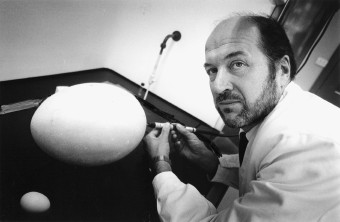Personal tools
News from ICTP 110 - What's New

Claudio Tuniz, ICTP's newly appointed special assistant to the director, has travelled the world. Now he has returned to the region of his birth in northeast Italy and he's glad to be back home.
Homeward Bound
It's often not easy to return
home after a 15-year absence. But Claudio Tuniz, ICTP's newly
appointed special assistant to the director, had an added incentive
to come back to his native Italy. It meant reuniting with his
family after nearly 15 years of long-distance commutes.
Tuniz explains. "In 1991, I was appointed lead scientist
of the accelerator mass spectrometry group for the Australian
Nuclear Science and Technology Organization (ANSTO) in Sydney,
marking the beginning of a rewarding career in Australia. Five
years later, I was promoted to the position of director of ANSTO's
100-person physics division. Then, in 2000, I relocated to the
Australian Embassy in Vienna, Austria, to represent the Australian
government at the International Atomic Energy Agency (IAEA) on
issues related to science and technology."

In 1993, Claudio Tuniz's Australian-based accelerator mass spectrometry group attracted worldwide attention when it helped date a giant egg of the flightless Aepyornis Maximum (Elephant Bird) found in the desert near Perth, Australia. Scientists believe that the 2000-year-old egg, equivalent in size to 150 normal-sized eggs, floated to Australia from Madagascar, landing ashore without a scratch.
"Throughout my far-flung journeys, my wife, a professor
of economics at the University of Udine, remained in Italy, doing
most of the commuting so that we could be together as often as
possible. While we both enjoyed our experience abroad, we both
had grown weary of our 'in-jet' life-style. Italy beckoned and
I knew it was time."
As a result, Tuniz, who was born in the small village of San Canzian
d'Isonzo, near Gorizia in northeastern Italy, moved home last
spring to begin the next phase of his life. Within a month of
his arrival, he was at work in ICTP's Main Building, where he
was greeted by several of his former University of Trieste professors---including
Gallieno Denardo, GianCarlo Ghirardi and Giuseppe Furlan. Tuniz
earned a doctorate in physics from the University of Trieste in
1974.
During the first decade of his career, Tuniz found himself hard
at work at a number of institutions, including the National Institute
for Nuclear Physics (INFN) and the Elettra Synchrotron
Light Laboratory in Italy, and Rutgers University and Brookhaven
National Laboratory in the United States, where he engaged in
research projects ranging from the development of accelerator-based
analytical methodologies for counting rare atoms to pioneering
applications of radionuclides designed to cast light on the cosmic
record embedded in meteorites and lunar rocks.
Tuniz is not only delighted to be back in Trieste but glad to
be working at ICTP, an organisation that he calls "an international
treasure that has had an enormous impact on global science and,
yet, has enormous potential to do even more."
As the director's special assistant, Tuniz will take the lead
in exploring new opportunities to strengthen ICTP's cooperative
activities with the United Nations Educational, Scientific and
Cultural Organization (UNESCO), IAEA and other UN organisations,
concentrating on such areas as education and training, knowledge
management and the application of physics to cultural heritage.
Tuniz also hopes to explore the possibility of cooperative projects
with European scientific institutions through the European Commission's
Framework Programme for Research and Technological Development.
"My own major field of scientific research has focused largely
on studies that rely on long-lived radioisotopes generated by
galactic cosmic rays that subsequently reside in the Earth's atmosphere
and landmass. Such isotopes have proven useful in dating climatic
events---for example, the last Ice Age that occurred 20,000 years
ago---as well as such prehistoric cultural phenomena as the rock
paintings of Australian aborigines."
"After many years as a civil servant vagabond in pursuit
of scientific adventures around the globe, I am glad to have finally
found my way back home," says Tuniz. "I know my family
is happy to be back together again and I can only hope that ICTP
will be happy with my efforts."